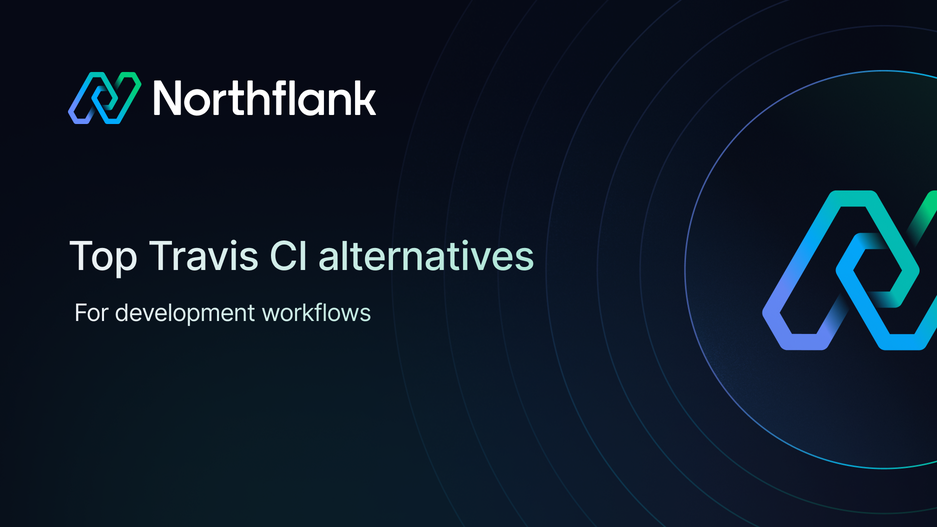

Top Travis CI alternatives for development workflows in 2025
You're looking for Travis CI alternatives for likely reasons:
- "We want integrated hosting and infrastructure management alongside CI/CD to reduce tool sprawl"
- "We need native preview environments so our team can review changes in full application stacks"
- "We're looking for visual release pipeline management with advanced workflows and rollback capabilities"
- "We want the flexibility to bring our own cloud infrastructure for compliance and cost control"
- "Our team needs a platform built container-native and Kubernetes-native from the ground up"
That's exactly what we'll help you with. We'll compare the top Travis CI alternatives for 2025, looking at their architecture, deployment capabilities, and how they fit modern development workflows.
This quick list summarizes the Travis CI alternatives we'll compare - we'll go into more detail later in the article:
- Northflank – Full-stack cloud platform combining CI/CD, hosting, databases, and release management. Built for container-native workflows with native Kubernetes support, true preview environments, and multi-cloud flexibility. Best for teams wanting unified build-deploy-host capabilities without operational overhead.
- GitLab CI/CD – Integrated CI/CD within the GitLab DevOps platform, ideal for teams already using GitLab for version control.
- CircleCI – CI/CD platform with caching, parallelism, and extensive integrations for complex pipeline requirements.
- Jenkins – Open-source automation server with plugin ecosystem and infrastructure control.
- GitHub Actions – Built into GitHub with workflow automation and marketplace actions for GitHub-centric development.
- Harness – Platform with AI-powered deployment analysis, canary deployments, and governance features.
When evaluating CI/CD platforms, consider these key factors:
- Architecture and infrastructure: Native support for your technology stack, particularly containers and Kubernetes. Platforms like Northflank are built container-native from day one, while others add support through plugins or configuration.
- Build performance: Fast build times, efficient caching, and the ability to scale parallel jobs without hitting hard limits or experiencing long queue times.
- Developer experience: Clean interfaces, comprehensive documentation, intuitive configuration, and tools that match your workflow, including UI, CLI, and API access.
- Deployment capabilities: Some platforms only handle CI, requiring separate solutions for hosting and infrastructure. Northflank provides integrated deployment, hosting, and database management alongside CI/CD.
- Environment management: Native support for preview environments, staging, and production environments with easy promotion between stages. True ephemeral environments that include full application stacks differentiate modern platforms.
- Release management: Visual pipeline tools, release flows, rollback capabilities, and deployment strategies beyond basic automation.
- Integration ecosystem: Compatibility with your existing tools, version control platforms, notification systems, and cloud providers.
- Pricing transparency: Clear, predictable pricing models that scale fairly with your usage without hidden costs or surprise charges.
- Multi-cloud flexibility: The ability to deploy across different cloud providers or bring your own infrastructure. Northflank supports deployment on its managed cloud or your own GKE, EKS, AKS, or bare-metal Kubernetes clusters.
Let's examine these platforms and compare them based on architecture, deployment capabilities, developer experience, and infrastructure flexibility:
Northflank is a full-stack cloud platform built for modern, cloud-native development workflows. Rather than just handling CI/CD, Northflank provides an integrated solution for building, deploying, hosting, and managing your entire application stack, including databases and services.
The platform is designed for teams working with containers and Kubernetes, but removes the operational complexity typically associated with these technologies. You get the power and flexibility of Kubernetes without needing dedicated DevOps expertise.
What makes Northflank stand out
Northflank is container-native from the ground up, removing the tool sprawl that comes from combining separate CI/CD, hosting, and infrastructure management solutions.
The platform provides true preview environments that automatically spin up complete ephemeral stacks, including applications, databases, and services for every pull request.
With visual release pipelines, multi-cloud support, and native GPU capabilities for AI/ML workloads, Northflank handles the full application lifecycle from git push to production.
Core capabilities of Northflank
- Rapid CI/CD pipelines: Container-native builds with automatic triggers from GitHub, GitLab, and Bitbucket
- Deployment and hosting: Deploy and host applications, managed databases, and scheduled jobs without separate platforms
- True preview environments: Automatic ephemeral environments with full application stacks for every PR
- Visual release pipelines: Multi-stage workflows with conditional logic, approvals, and one-click rollbacks
- Kubernetes without complexity: Native Kubernetes support with automatic scaling and orchestration
- Multi-cloud and BYOC (Bring Your Own Cloud): Deploy on Northflank's cloud or bring your own AWS, GCP, Azure, or bare-metal infrastructure
- GPU workload support: Native support for NVIDIA H100, B200, and other GPU configurations for AI/ML
- Infrastructure as code: Reusable templates for consistent deployments across environments
- Comprehensive observability: Built-in logs, metrics, and alerts with integration to monitoring tools
- Developer-first tooling: Modern UI, CLI, and API for workflow automation
Best for
Teams building cloud-native applications with microservices architectures, organizations wanting integrated CI/CD and hosting without tool sprawl, developers prioritizing preview environments as core workflow, teams needing multi-cloud or bring-your-own-cloud flexibility, and those working with GPU-accelerated workloads for AI and ML.
Learn more about continuous integration and delivery on Northflank and see how to set up a pipeline.
GitLab CI/CD integrates directly into the GitLab platform, providing CI/CD alongside version control, project management, and security scanning. The platform uses configuration files to define pipelines with both cloud-hosted and self-hosted deployment options.
Key features
- Docker and Kubernetes support – Native container orchestration and deployment capabilities
- Integrated security scanning and compliance – Built-in vulnerability scanning, dependency checking, and compliance reporting
- Container registry and artifact storage – Host Docker images and build artifacts within GitLab
- Cloud and self-hosted runners – Run builds on GitLab's infrastructure or your own servers
- Pipeline visualization and debugging – Visual pipeline editor with detailed logs and debugging tools
Best for
Teams already using GitLab for version control.
Compare GitLab and other alternatives for platform selection.
CircleCI offers customizable workflows with caching, parallelism, and extensive integrations. The platform supports Docker, Kubernetes, and VM-based workflows with both cloud and self-hosted options.
Key features
- Advanced caching and parallelism – Speed up builds with intelligent dependency caching and parallel job execution
- Docker, Kubernetes, and VM support – Run builds in containers, Kubernetes clusters, or traditional VMs
- Customizable YAML workflows – Define complex multi-stage pipelines with conditional logic
- Cloud and self-hosted runners – Use CircleCI's cloud infrastructure or run on your own hardware
- Resource class controls – Select CPU and memory configurations for different build requirements
Best for
Teams with complex pipeline requirements needing extensive customization.
See top CircleCI alternatives for additional comparisons.
Jenkins is an open-source automation server with thousands of plugins for customization. The platform requires self-hosting and manual configuration, providing complete control over infrastructure.
Key features
- Extensive plugin ecosystem – Access thousands of community plugins for integrations and functionality
- Infrastructure control – Full control over build servers, configurations, and security settings
- Customizable pipeline scripts – Write pipelines as code using Groovy-based DSL
- Support for any workflow – Build, test, and deploy any technology stack or deployment target
- Active open-source community – Large user base with extensive documentation and support
Best for
Teams wanting complete infrastructure control with dedicated DevOps resources.
Review Jenkins alternatives in 2025 for modern options.
GitHub Actions integrates directly into GitHub repositories with workflow automation and marketplace actions. The platform automatically triggers on repository events with managed or self-hosted runners.
Key features
- Native GitHub integration – Workflows trigger automatically on commits, PRs, and other repository events
- Marketplace of reusable actions – Thousands of pre-built actions for common tasks and integrations
- Matrix builds across environments – Test code across multiple OS versions, languages, and configurations
- Managed and self-hosted runners – Use GitHub's infrastructure or run workflows on your own servers
- Secrets management within GitHub – Store and access credentials securely within repository settings
Best for
Teams with workflows centered on GitHub repositories.
Compare GitHub Actions alternatives for broader evaluation.
Harness provides continuous delivery with AI-powered deployment analysis, canary deployments, and advanced governance features.
Key features
- AI deployment analysis – Machine learning models analyze deployments to detect anomalies and failures
- Canary and blue-green deployments – Progressive rollout strategies with automated traffic shifting
- Integrated feature flags – Control feature releases independently from deployments
- Audit logging and compliance – Complete deployment history with approval workflows and governance policies
- Multi-cloud infrastructure support – Deploy across AWS, GCP, Azure, and other cloud providers
Best for
Large enterprises with complex deployment and governance requirements.
Check out top Harness alternatives for enterprise comparisons.
When choosing between Travis CI alternatives, your decision depends on your specific workflow requirements and infrastructure needs. This table breaks down which platform fits different use cases:
Note: Northflank integrates with GitLab, GitHub, and Bitbucket, supports multi-cloud flexibility, and includes enterprise governance features. This table highlights where each platform is the primary/natural fit based on their core design
| Use case | Best platform | Why |
|---|---|---|
| Integrated CI/CD and hosting | Northflank | Unified platform for build, deploy, and host without separate tools |
| Existing GitLab users | GitLab CI/CD | Native integration removes context switching |
| Maximum flexibility | Jenkins | Complete control through extensive plugin ecosystem |
| GitHub-centric workflows | GitHub Actions | Seamless repository integration |
| Enterprise governance | Harness | Advanced deployment strategies and compliance features |
| Container-native development | Northflank | Built for Docker and Kubernetes from the ground up |
| Preview environments | Northflank | Full ephemeral stacks with applications and databases |
| Multi-cloud deployment | Northflank | Deploy anywhere with bring-your-own-cloud support |
This starts with understanding your workflows and choosing projects to migrate incrementally. Follow these steps:
- Document your current setup – Map your existing configurations, deployment targets, and integrations before beginning the transition.
- Start with a pilot project – Choose a smaller, non-critical project to learn the new platform. Most platforms provide migration guides and configuration converters. Northflank offers comprehensive documentation on managing CI/CD and infrastructure as code to support migration.
- Run parallel systems – Set up parallel runs where both systems process the same commits, allowing validation before full cutover.
- Migrate incrementally – Move projects gradually rather than attempting wholesale replacement.
- Update documentation – Update your team documentation with new processes and configurations.
Getting started with Northflank
Northflank provides integrated CI/CD, deployment, and hosting in a single platform. Connect your GitHub, GitLab, or Bitbucket repositories to start building.
Deploy services, databases, and jobs using guided setup. Configure continuous integration and delivery with automatic builds, set up ephemeral preview environments for pull requests, and build visual workflows for complex release processes.
Start building on Northflank's free developer sandbox or book a demo with our engineering team to discuss specific requirements.
Understanding CI/CD strategies helps optimize your development workflow:
- Continuous deployment – Automated deployment strategies for production
- Continuous delivery – Keeping code deployable with manual approval gates
- Continuous deployment tools – Comprehensive tool comparisons
- Using GitHub Actions with Northflank – Integrate existing workflows
Access the full Northflank documentation for platform guides and best practices.